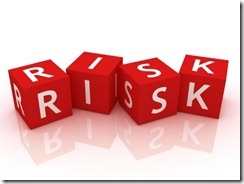Risk Assessment: A Major Key to Great Investing (Featured News)
Ask any finance pro why most individual investors never get rich and the answers will vary. Some will say fear to act, some greed and some lack of patience. While all of these factors are certainly possible, there’s one that trumps them all: “their inability to assess risk.”
Question a few people about what they think of the stock market. Most likely, the answers will be something along the lines of “It’s a good way to lose all your money” or “It’s nothing but a big gambling game” or “It’s rigged against the little guy.”
These same folks think nothing of parking their money in a low-interest savings account year after year, blithely ignoring the fact that the purchasing power of their funds is being wiped out by inflation.
Too many investors get caught up in all the negative news pumped out by the media and ignore the longer-term performance of the stock market. Try telling Sally and Joe Middle America that a diversified stock portfolio is safer, over the long term, than bonds, bank accounts, or gold. It’s almost guaranteed they won’t believe you, especially if the market is gyrating as we have seen lately or in a slump like we saw in ‘08.
Generally, our perception of risk works exactly backwards: when stocks, real estate, or any other asset class is getting cheaper, and therefore more value-positioned and possibly safer, we perceive it as riskier because it has lost some and may still be losing more of its value. When it’s increasing in price, moving toward full market valuation and therefore more dangerous, many perceive it as safer.
The time when the “man on the street” tells you stocks are a great buy is when they definitely aren’t. If a shoe clerk starts giving you stock tips, it’s time to take your money and run.
Here are five ways you can improve your ability to assess risk:
1) Block out the last few days or weeks. Look at what’s happening over a period of one to three years. Focusing only on what’s happening this week will lead you astray every time.
2) Evaluate all your alternatives. There is usually someone, somewhere who’s making money. If you don’t like the odds in the United States, look at other countries, including emerging markets. Consider micro and small cap opportunities that don’t necessarily move with the general direction of the market.
Look at various asset classes if you are so inclined including real estate, precious metals and other alternative investments such as commodities and long-short funds. But be forewarned: If everyone loves an asset class, it may not be your best choice.
3) Ask yourself what’s the worst that can happen. Get a handle on your economic fears by playing out various scenarios in your head. Is Johnson and Johnson going to stop selling cotton balls? Are people going to stop driving their cars and consuming petroleum products?
4) Keep in mind that “riskier” assets can be the most popular ones. Safety stocks are great, but they’re also in greater demand when things are bad which can drive their prices higher. The biggest bargains in a bad economy are usually in the small and micro cap areas. Buy a diversified portfolio of small caps, and you’ll have less risk than you might think.
Of course, any one of them may go bankrupt, but they’re not all going to go bankrupt at the same time unless this really is the end of the world. If small caps and micro caps are too frightening for you, remember that a good market panic will drop the price of the stalwarts too. You may not make as much on the blue chips as you would in the best small caps, but it still won’t be very hard to beat the performance of the average bond or T-bill.
5) Look at facts, not opinions. Read several good books on stock market history, and compare the long-term returns of various assets. Look at seasonal anomalies like year-end tax selling and summer slumps. Pay attention to the returns of small versus large caps. Look for things that are almost always true, and use them to guide your investing.
Memorize principles like “Small caps and mid caps tend to outperform large caps” and “Investors who check their portfolios constantly do worse than those who check in once a month.” A solid set of principles will provide a much more reliable guide than listening to what the talking heads think this week. Remember, they have to fill the air waves with something…and it’s not always something you need to hear.
Watching too much television or listening to too much water cooler chatter will lead you to invest in exactly the wrong things at the wrong time.
Examine fundamentals when you’re tempted to panic. If your company has little or no debt and positive earnings, it’s probably not going bankrupt any time soon. When the fundamentals tell a different story than the share price, wait a while. The two will come back into line; they always do.
Conclusion
The biggest threat to investors’ wallets is the misperception of risk. They buy things that are riskier than they think and bypass those that are actually safer. You can do better by looking at the actual facts behind the performance of your assets and turning off the noise.
Posted by the Research Staff
MicroCap MarketPlace






